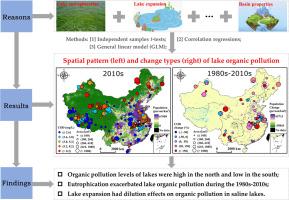Eutrophication exacerbated organic pollution in lakes across China during the 1980s–2010s
IF 11.4
1区 环境科学与生态学
Q1 ENGINEERING, ENVIRONMENTAL
引用次数: 0
Abstract
Lakes are vital sources of drinking water and essential habitats for humans and various other living organisms. However, many lakes face organic pollution due to anthropogenic disturbance and climatic influence, and the spatiotemporal changes of organic pollution in lakes over a large area are still unclear. Based on three monitoring datasets of chemical oxygen demand (COD) in 390 lakes, this study demonstrated the apparent spatiotemporal differences of organic pollution in lakes during the 1980s–2010s and the effects of water eutrophication and salinization. Throughout China, lake organic pollution showed a general spatial trend of being more severe in the north compared to the south. This pattern is reflected in the positive linear correlations between in-situ COD concentrations and lake latitude, observed in both the 1980s (p < 0.05) and the 2010s (p < 0.01). In terms of spatial differences, the influence of total nitrogen concentrations increased from 0.27% in the 1980s to 35.24% in the 2010s. Moreover, with increasing human activity, 78.31% of the studied lakes (N = 83) showed increasing COD concentrations during the 1980s–2010s. In addition, the logarithmic dissolved organic carbon concentrations were linearly correlated with log water conductivities (Pearson's r = 0.49, p < 0.01), suggesting that lake expansion would attenuate organic pollution in saline lakes through dilution effects. These results are valuable for understanding the spatiotemporal dynamics of organic pollution and are crucial for effective management of organic pollution in different lakes.

20 世纪 80 年代至 2010 年代,富营养化加剧了中国各地湖泊的有机污染
湖泊是重要的饮用水源,也是人类和其他各种生物的重要栖息地。然而,由于人为干扰和气候影响,许多湖泊面临有机污染问题,而大面积湖泊有机污染的时空变化仍不清楚。本研究基于 390 个湖泊的化学需氧量(COD)监测数据集,展示了 20 世纪 80 年代至 2010 年代湖泊有机污染的明显时空差异,以及水体富营养化和盐渍化的影响。在全国范围内,湖泊有机污染总体上呈现出北重南轻的空间趋势。20 世纪 80 年代(p < 0.05)和 2010 年代(p < 0.01)观测到的原位化学需氧量浓度与湖泊纬度之间的正线性相关反映了这一规律。在空间差异方面,总氮浓度的影响从 20 世纪 80 年代的 0.27% 增加到 2010 年代的 35.24%。此外,随着人类活动的增加,在 20 世纪 80 年代至 2010 年代期间,78.31% 的研究湖泊(N = 83)的化学需氧量浓度呈上升趋势。此外,对数溶解有机碳浓度与对数水电导率呈线性相关(Pearson's r = 0.49, p <0.01),表明湖泊扩大将通过稀释效应减轻盐湖中的有机污染。这些结果对了解有机污染的时空动态很有价值,对有效管理不同湖泊的有机污染至关重要。
本文章由计算机程序翻译,如有差异,请以英文原文为准。
求助全文
约1分钟内获得全文
求助全文
来源期刊

Water Research
环境科学-工程:环境
CiteScore
20.80
自引率
9.40%
发文量
1307
审稿时长
38 days
期刊介绍:
Water Research, along with its open access companion journal Water Research X, serves as a platform for publishing original research papers covering various aspects of the science and technology related to the anthropogenic water cycle, water quality, and its management worldwide. The audience targeted by the journal comprises biologists, chemical engineers, chemists, civil engineers, environmental engineers, limnologists, and microbiologists. The scope of the journal include:
•Treatment processes for water and wastewaters (municipal, agricultural, industrial, and on-site treatment), including resource recovery and residuals management;
•Urban hydrology including sewer systems, stormwater management, and green infrastructure;
•Drinking water treatment and distribution;
•Potable and non-potable water reuse;
•Sanitation, public health, and risk assessment;
•Anaerobic digestion, solid and hazardous waste management, including source characterization and the effects and control of leachates and gaseous emissions;
•Contaminants (chemical, microbial, anthropogenic particles such as nanoparticles or microplastics) and related water quality sensing, monitoring, fate, and assessment;
•Anthropogenic impacts on inland, tidal, coastal and urban waters, focusing on surface and ground waters, and point and non-point sources of pollution;
•Environmental restoration, linked to surface water, groundwater and groundwater remediation;
•Analysis of the interfaces between sediments and water, and between water and atmosphere, focusing specifically on anthropogenic impacts;
•Mathematical modelling, systems analysis, machine learning, and beneficial use of big data related to the anthropogenic water cycle;
•Socio-economic, policy, and regulations studies.
 求助内容:
求助内容: 应助结果提醒方式:
应助结果提醒方式:


